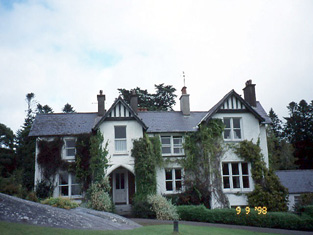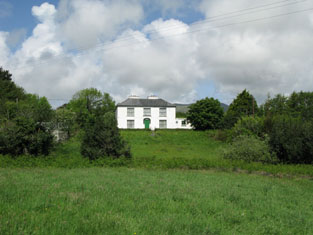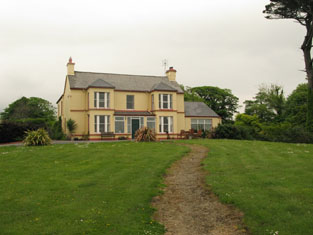Reen Lodge
Houses within 15km of this house
Displaying 13 houses.
Houses within 15km of Reen Lodge
Displaying 13 houses.
| House name | Description | |
|---|---|---|
| Derreen | Peter McSweeney was leasing the property at Derreen from the Lansdowne estate at the time of Griffith's Valuation, when it was valued at £6 10s. Lewis also notes it as his residence in 1837. Bary states that Derreen was originally built by a branch of the O'Sullivans from whom it passed to Peter McSweeney who was married to a member of that family. It formed part of the Lansdowne estate and later came into the possession of the Petty-Fitzmaurices. In 1906 it was owned by that estate and was valued at £53 15. It was burnt in the early 1920s but rebuilt in the same style and is still extant and occupied. It is famous for its beautiful gardens. |

|
| Four Mile Water Court or Durrus Court | Rev. Alleyn Evanson was leasing this property from the Earl of Bandon's estate at the time of Griffith's Valuation, when it was valued at £15. It is labelled Four Mile Water Court on the 1st edition Ordnance Map and Durrus Court on the later 25-inch edition. In 1837, Lewis recorded it as Four Mile Water Court, the seat of A. Evanson. It is still extant. | |
| Fort Lodge | John B. Gumbleton was leasing this property to Richard Donovan at the time of Griffith's Valuation, when it was valued at £7. In 1837 Lewis noted it as the seat of R. O'Donovan. It is now in ruins. | |
| O'Donovan's Cove | Timothy O'Donovan held this property in fee at the time of Griffith's Valuation, when it was valued at £12. Lewis recorded it as the seat of T.O'Donovan in 1837. It is described as "in ruins" on the 25-inch map of the 1890s and no trace remains now. | |
| Dunbeacon House | Richard Townsend held this property in fee at the time of Griffith's Valuation, when it was valued at £11 5s. In 1906 it was also the property of Richard Townsend and valued at £8. | |
| Glengarriff Lodge | Held in fee by the Earl of Bantry's estate at the time of Griffith's Valuation, when it was valued at £9. The house was a specially designed hunting lodge for the Bantry estate. It remained in the estate's ownership until the 1940s. Though badly damaged by fire in the 1960s it has been completely renovated and now serves as luxury self-catering accommodation. See www.glengarriff-lodge.com. |

|
| Adrigole House | Rev. Richard Wright was leasing this property from the Bantry estate in 1852 when it was valued at £9. It is labelled Ardrigole Parsonage on the 1st edition Ordnance Survey map but appears as Adrigole House on the 25-inch edition of the 1890s. IN the early 1940s the Irish Tourist Association survey described it as "an old square building completely covered in ivy" and the property of a Mr. Crowley. It is still extant and has been offered for sale in recent years. | |
| Mill Cove (Bear) | Leased by Patrick O'Sullivan from the Earl of Bantry's estate in 1852 when it was valued at £14. Local sources suggest O'Sullivan worked as an agent for the White estate. The house has been demolished though traces of the stone work can still be seen in the gardens which are now part of an art gallery and sculpture display. | |
| Cametringane House | In use at the time of Griffith's Valuation, as an Auxiliary Workhouse, on lease from the Earl of Bantry's estate. The house was then valued at almost £18. Lewis referred to it as the seat of J. O'Sullivan in 1837. In use as a hotel towards the end of the twentieth century. | |
| Glebe House (Killaconenagh) | Held in fee by Rev. Thomas O'Grady in 1852 when the house was valued at £11 5s. In 1942 the Irish Tourist Association Survey reported the Glebe House as the residence of Reverend Wolfe and that it had been the birthplace of the well-known author, Standish James O'Grady. This appears to be the house noted as Heathmount by the National Inventory of Architectural Heritage. |

|
| Lancet Lodge | The Puxley estate owned two houses in this townland at the time of Griffith's Valuation, in 1852. One, valued at £14 10s, was leased by John Greenway. It is labelled Dispensary on the 1st edition Ordnance Survey map and as Lancet Lodge on the 25-inch edition of the 1890s. The house is still extant and occupied. The second property, valued at £10, was leased by Phillip Armstrong. It is not labelled on the 1st Edition Ordnance Map. [Grid Reference approximate] | |
| Dunboy Castle | Noted by Lewis as the residence of J.L. Puxley in 1837 and held in fee by him in 1852, when the property was valued at £50. In 1894 Slater refers to it as the residence of R. O'Brien Studdert who had married, as his second wife, Maria Puxley. In 1906 the mansion was the property of Henry L. Puxley and valued at £85. The original house was built in several stages, the most recent in the 1860s, close to the ruins of the old O'Sullivan castle, the site of the siege of Dunboy in 1602. The Puxley mansion was burnt in June 1921 during the War of Independence and remained a ruin until the early years of this century. Restoration work has taken place with the intention of converting the house to a hotel but this has not yet reached completion. |

|
| Brandy Hall | Daniel Leah yheld this property in fee at the time of Griffith's Valuation though it is not clear if he was occupying it. It was valued at almost £5. The National Inventory of Architectural Heritage suggests it was built c.1830 and altered in the early twentieth century. It is still extant and occupied and has been offered for sale in recent years. |

|

